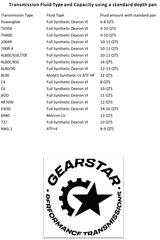3 Symptoms Of A Failing 4L60E Transmission And How To Diagnose The Problems
The 4L60E transmission by General Motors first came onto the scene in 1992 where it served as a replacement or upgrade to the 700R4 transmission. Although both transmissions were quite similar, it was the first time when GM shifted from a hydraulically-controlled transmission to an electronically-controlled one. The transmission was used in a large number of vehicles, including GM vans, SUVs, trucks, as well as many rear-wheel-drive cars. Some of the most popular cars that used the transmission include the Chevrolet Corvette, Camaro, Impala, and more.
Just like any other transmission, 4L60E can also experience problems and might require an upgrade. For better performance, get automatic transmission rebuild kits. Here are 3 symptoms of a failing 4L60E transmission and how to diagnose the problems:
- No Third Gear - You put the vehicle in drive, start off the transmission, and shift to second gear. Everything works fine until you go to the third gear. When you put your vehicle in third gear, the engine runs away as if it's in neutral. The problem? 3-4 clutch pack failure! Take the bell off, pull the pan, take out the filter and solenoids, pull the pump and drone, separate the drone, and what you will see is a burned up 3/4 clutch pack. But what causes it? The 3/4 piston rubber seals shrink from heat and age. Hydraulic pressure blows around it and the clutch pack fries. What you need are a new piston and a clutch pack.
- No Second Gear/Reverse - The second most common symptom of a failing 4L60E transmission is your inability to shift to second gear and go reverse. The reason? A broken drive shell! Open the shell. After the drums are removed, remove the snap ring, pull out the planetary gearset, remove the input ring gear, and check the drive shell. Though the shell is supposed to be one piece, not only can it break off, but it can also strip out the splines.
- Hard Second Gear- The third most common symptom of a failing 4L60E transmission is the difficulty in shifting to the second gear. The second is so hard that it almost feels like a shift kit has been installed. A diagnostic scan comes up that shows code 1870 internal slippage. The reason? A worn TCC regulator valve! The “check engine” light might turn on. The problem is in the valve body. Pull the pan and the filter, remove the solenoids and wiring harness, remove the valve body bolt, lift the valve body, and turn it over. The TCC regulator valve is located there. It wears out and causes the converter clutch to slip.
Repair Choices
- Get an oversized replacement valve and reamer.
- Use the spring provided in high-quality automatic transmission rebuilds kits. Just remove the clip in plug and valve assembly and replace the spring, valves plug, and clip. This essentially fixes the problem. The spring prevents the valve from moving this and stops leakage.
Looking for high-performance automatic transmissions for your vehicle? Gearstar is the place to go! Find the right transmissions for your model and get the most out of your car.



